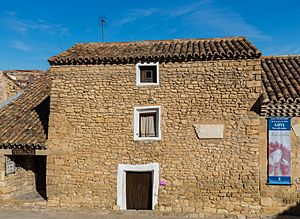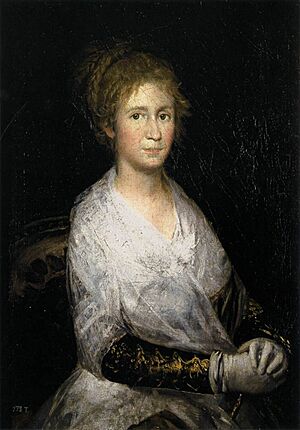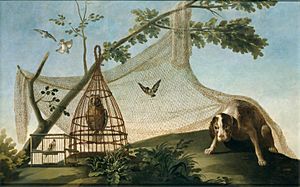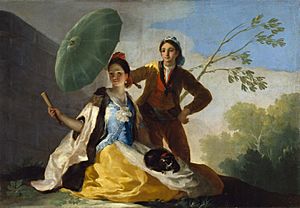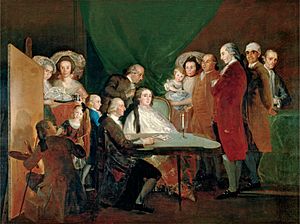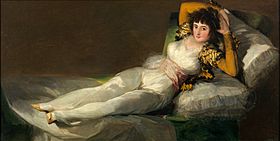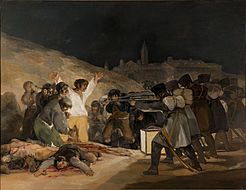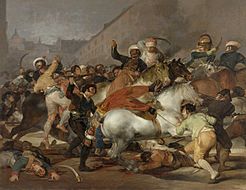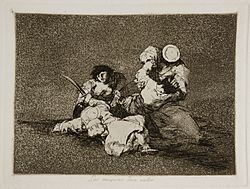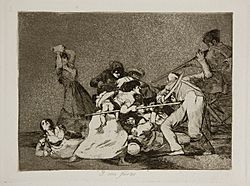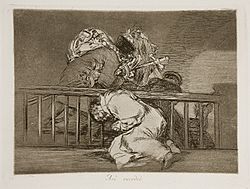Francisco Goya facts for kids
Quick facts for kids
Francisco de Goya
|
|
|---|---|

|
|
| Born |
Francisco José de Goya y Lucientes
30 March 1746 |
| Died | 16 April 1828 (aged 82) |
| Known for | Painting, drawing |
|
Notable work
|
List of paintings and engravings |
| Movement | Romanticism |
Francisco José de Goya y Lucientes (born March 30, 1746 – died April 16, 1828) was a famous Spanish painter and printmaker. He is known as one of the most important Spanish artists from the late 1700s and early 1800s. His art, including paintings, drawings, and prints, showed the big changes happening in the world at that time. Goya is often called the last of the Old Masters (great artists from before the 1800s) and the first of the modern artists.
Goya was born into a middle-class family in 1746 in a town called Fuendetodos in Aragon, Spain. He started studying painting when he was 14. Later, he moved to Madrid to continue his studies. In 1773, he married Josefa Bayeu, and they had one son who lived to be an adult. By 1786, Goya became a painter for the Spanish royal family. During this early part of his career, he painted many portraits of important people and created designs for tapestries in the royal palace.
In 1793, Goya became very ill and lost his hearing. After this, his artwork became darker and more serious. His later paintings and prints often showed a sad view of life, society, and politics. Even so, he continued to rise in his career. In 1795, he became the Director of the Royal Academy of Art. By 1799, he was the top court painter in Spain. Around this time, he painted his famous La maja desnuda.
In 1807, Napoleon's French army invaded Spain, starting the Peninsular War. Goya stayed in Madrid during the war, and the conflict deeply affected him. Although he didn't speak much about his feelings in public, his art showed his thoughts. His series of prints called Disasters of War (published after his death) and his 1814 paintings The Second of May 1808 and The Third of May 1808 clearly show his feelings about the war. Other works from this time explored themes like madness, witches, and corruption.
His later works include the Black Paintings, which he painted directly onto the walls of his house between 1819 and 1823. He lived almost alone in this house, called the Quinta del Sordo (House of the Deaf Man), feeling disappointed with the political situation in Spain. In 1824, Goya left Spain and moved to Bordeaux, France. There, he continued to create art, including his La Tauromaquia series about bullfighting.
Goya passed away on April 16, 1828, at the age of 82, after a stroke that left him partly paralyzed and with poor eyesight. His body was later moved to Madrid.
Contents
- Early Life and Art Training (1746–1771)
- Becoming a Court Painter in Madrid (1775–1789)
- Working for the Royal Family
- A Time of Change and Illness (1793–1799)
- The Peninsular War (1808–1814)
- The Black Paintings (1819–1822)
- Life in Bordeaux (1824–1828)
- Goya's Influence on Art and Culture
- Images for kids
- See also
Early Life and Art Training (1746–1771)
Francisco de Goya was born in Fuendetodos, Aragon, Spain, on March 30, 1746. His parents were José Benito de Goya y Franque and Gracia de Lucientes y Salvador. His family was lower middle-class. His father worked as a gilder, decorating religious and other artworks with gold. He even helped with the decorations at the main cathedral in Zaragoza, the Basilica of Our Lady of the Pillar. Francisco was the fourth of six children.
Around 1749, Goya's family moved to the city of Zaragoza. It is believed that Goya went to a free school there. He learned to read, write, and do math. He also became good friends with a fellow student named Martín Zapater. The many letters Goya wrote to Zapater later in life give us a good idea of Goya's early years.
Studying Art in Italy
When Goya was 14, he began studying with the painter José Luzán. He copied other artists' works for four years. He then decided to create his own art. He moved to Madrid to study with Anton Raphael Mengs, a popular painter for the Spanish royal family. However, Goya didn't get along with Mengs, and his art exams were not very good. He tried to join the Real Academia de Bellas Artes de San Fernando (Royal Academy of Fine Arts) in 1763 and 1766 but was not accepted.
Rome was a very important art center in Europe at that time. Goya decided to travel to Rome on his own in 1770, following a tradition of many European artists. He was not well-known then, so there are not many records of his time there. In 1771, he won second prize in a painting competition in Parma, Italy.
After his trip to Italy, Goya returned to Zaragoza in 1771. He painted parts of the Basilica of Our Lady of the Pillar and other churches. He also studied with the artist Francisco Bayeu y Subías. Goya's paintings started to show the soft colors and tones that he would become famous for. He became friends with Francisco Bayeu and married his sister, Josefa, on July 25, 1773. Their first child, Antonio, was born in 1774.
Becoming a Court Painter in Madrid (1775–1789)
Francisco Bayeu, Goya's brother-in-law, was a member of the Royal Academy and helped Goya get a job designing tapestries for the Royal Tapestry Factory. Over five years, Goya created about 42 designs. These designs were used to decorate the walls of royal homes like El Escorial and the Royal Palace of El Pardo. Even though designing tapestries wasn't the most important or highest-paying job, Goya used these popular designs, often in a rococo style, to become more well-known.
Goya also created engravings, which are prints made from etched plates. He copied works by older masters like Diego Velázquez. Etching became a very important way for Goya to show his imagination and his thoughts about politics. His 1779 etching called The Garrotted Man showed a dark scene and hinted at the powerful anti-war prints he would create later.
Goya faced illnesses during this time, and his rivals sometimes used his health against him. Some of his large tapestry designs were physically demanding to create. However, Goya used his illness to his advantage, saying it helped him create more personal and unique artworks. He found the tapestry format limiting because it didn't allow him to use complex colors or textures.
Working for the Royal Family
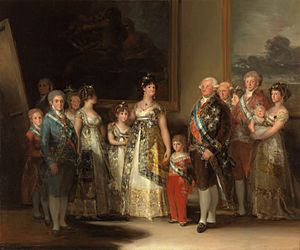
In 1783, the Count of Floridablanca, a favorite of King Charles III, asked Goya to paint his portrait. Goya also became friends with the King's half-brother, Luis, and spent two summers painting portraits of Luis and his family. During the 1780s, Goya gained more important clients, including the Duke and Duchess of Osuna and other nobles. In 1786, Goya was given a paid position as a painter for King Charles III.
In 1789, Goya was appointed court painter to King Charles IV. The next year, he became the First Court Painter, the highest rank for a Spanish court artist. He painted portraits of the King, the Queen, and the Prime Minister Manuel Godoy. These portraits are famous because they don't try to make the subjects look better than they are. His painting Charles IV of Spain and His Family is seen by many as a very honest, almost critical, look at the royal family. Some people think it shows the problems within Charles IV's rule. Queen Louisa was thought to have a lot of power, so Goya placed her in the center of the group portrait. Goya himself can be seen in the background of the painting, looking out at the viewer.

Goya received painting requests from the most important families in Spain. These included the Duke and Duchess of Osuna, the Duke and Duchess of Alba, and the Marchioness of Pontejos. In 1801, he painted a portrait of Godoy to celebrate Spain's victory in a short war against Portugal. Goya and Godoy were friends, even though Goya's 1801 portrait of Godoy is sometimes seen as a bit mocking. Godoy was also believed to have asked Goya to paint La maja desnuda.
A Time of Change and Illness (1793–1799)
La Maja Desnuda (The Naked Maja) is a famous painting of a woman without clothes. It is considered special because it was one of the first life-size paintings of a woman that wasn't meant to be a goddess or a character from a story. We don't know for sure who the woman in the painting was. Some people think it was the Duchess of Alba, or Pepita Tudó, who was the friend of Manuel de Godoy. The paintings were never shown to the public during Goya's life and were owned by Godoy. Later, the Spanish Inquisition (a religious court) took the paintings, but they were returned to the Academy of Fine Arts in 1836.
In 1798, Goya painted bright and airy scenes for the Chapel of San Antonio de la Florida in Madrid. Many of these paintings show miracles of Saint Anthony happening in the middle of everyday Madrid life.
Between late 1792 and early 1793, Goya became very ill and lost his hearing. This illness changed him, and he became more quiet and thoughtful. His art also changed, becoming darker and more serious. He started a series of prints called the Caprichos, which were published in 1799. These 80 prints showed what Goya called "the many silly and foolish things found in any civilized society." One famous print is called The Sleep of Reason Produces Monsters, which suggests that when people don't think clearly, bad things can happen. These prints also show Goya's sharp sense of humor.
While he was recovering from his illness in 1793 and 1794, Goya painted eleven small pictures on tin. These paintings showed a big change in his art. They explored dark and dreamlike themes. Yard with Lunatics shows a sad scene of people in a mental asylum. This painting shows Goya's concern for how people were treated. He said that these works helped him deal with his own worries and fears about losing his mind.
Goya's health problems might have been caused by a long-lasting viral infection or small strokes. Some experts also think he might have had lead poisoning. Goya used a lot of white paint, which contained lead, and he ground it himself.
The Peninsular War (1808–1814)
In 1808, the French army invaded Spain, starting the Peninsular War that lasted until 1814. We don't know exactly how involved Goya was with the French king, Joseph I, who was Napoleon's brother. Goya painted for some French supporters but tried to stay neutral during the fighting. When the Spanish King Ferdinand VII returned in 1814, Goya said he had not supported the French. Around the time his wife Josefa died in 1812, Goya was painting The Second of May 1808 and The Third of May 1808. He was also preparing his famous series of etchings known as The Disasters of War.
Even though Goya didn't say why he created The Disasters of War, art experts believe they are a strong protest against the violence of the 1808 Dos de Mayo Uprising and the war that followed. These prints show disturbing scenes of war, death, and destruction. They were not published until 1863, 35 years after Goya's death. It was probably only then considered safe to share artworks that criticized both the French and the Spanish rulers.
The first 47 prints in the series show events from the war and how they affected soldiers and ordinary people. The next part of the series (prints 48 to 64) shows the terrible famine that hit Madrid in 1811–12. The last 17 prints show the disappointment of people who wanted reforms when the Spanish monarchy returned and rejected the Spanish Constitution of 1812.
-
The Third of May 1808, 1814. This painting shows Spanish people being executed by French soldiers.
-
The Second of May 1808, 1814. This painting shows the uprising of the Spanish people against the French army.
From 1814 to 1819, Goya mostly painted portraits. He also created an altarpiece for the Seville Cathedral and a print series called La Tauromaquia, which shows scenes from bullfighting.
The Black Paintings (1819–1822)
Not much is known about Goya's final years. He kept many of his later works private. He was worried about getting old and losing his mind. Even though he had been a very successful artist, he lived a quiet life outside Madrid in his last years. His house became known as "La Quinta del Sordo" (The House of the Deaf Man), because the previous owner was also deaf.
Art experts believe Goya felt disconnected from the political and social changes happening in Spain after the monarchy returned in 1814. He thought these changes were a step backward. He had hoped for reforms, but like many who wanted change, he was disappointed when the monarchy and the church rejected the Spanish Constitution of 1812.
When he was 75 years old, feeling alone and in poor health, Goya created his 14 Black Paintings. He painted these directly onto the plaster walls of his house using oil paints. Goya did not plan for these paintings to be shown to the public, and he never wrote or spoke about them. Around 1874, about 50 years after his death, the paintings were carefully removed from the walls and moved onto canvas. Today, they are on display at the Museo del Prado in Madrid.
Life in Bordeaux (1824–1828)
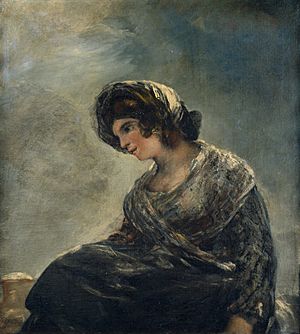
Leocadia Weiss (1790–1856) was Goya's maid and a distant relative. She was 35 years younger than him. She lived with and cared for Goya after his wife Josefa died. She stayed with him at his house until 1824, along with her daughter Rosario. Leocadia looked somewhat like Goya's first wife, Josefa Bayeu.
Leocadia had been unhappily married to a jeweler and had separated from him in 1811. She had two children before that, and a third child, Rosario, was born in 1814. Rosario's father was not Leocadia's husband, and some people have wondered if Goya was Rosario's father, though there is no strong proof.
Goya passed away on April 16, 1828. Leocadia was not mentioned in Goya's will. She wrote to Goya's friends to complain about this, but many of them were old or had passed away and did not reply. She was left with little money and later gave away her copy of Goya's Caprichos prints.
Goya's Influence on Art and Culture
Goya's art has had a big impact on many artists and writers who came after him.
- In the early 1900s, famous Spanish artists like Pablo Picasso and Salvador Dalí were inspired by Goya's Los caprichos and the Black Paintings.
- In the 21st century, American painters like Michael Zansky and Bradley Rubenstein have drawn ideas from Goya's "The Dream of Reason Produces Monsters" and his Black Paintings.
- The Spanish writer Fernando Arrabal's novel The Burial of the Sardine was inspired by one of Goya's paintings.
- The Russian poet Andrei Voznesensky wrote a poem called I Am Goya, inspired by Goya's anti-war paintings.
- The video game Impasto was based on Goya's artworks.
Images for kids
-
Portrait of Manuel Godoy, 1801. Real Academia de Bellas Artes de San Fernando
See also
 In Spanish: Francisco de Goya para niños
In Spanish: Francisco de Goya para niños


